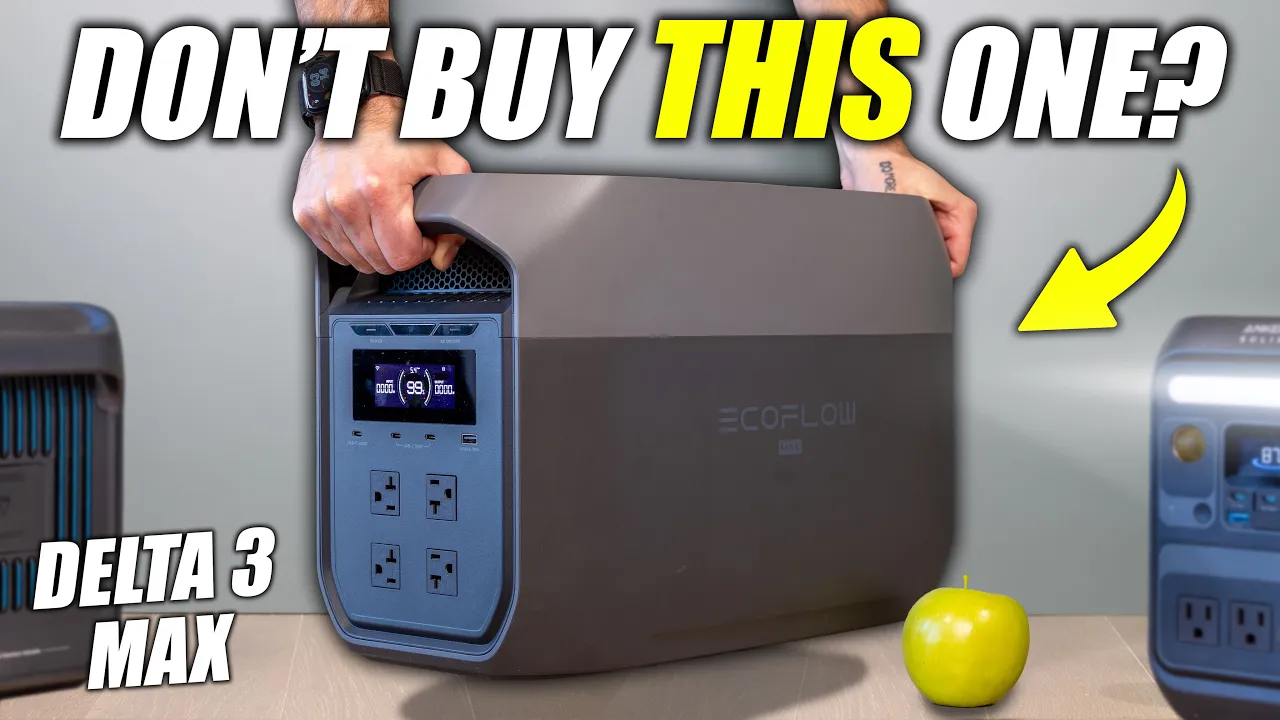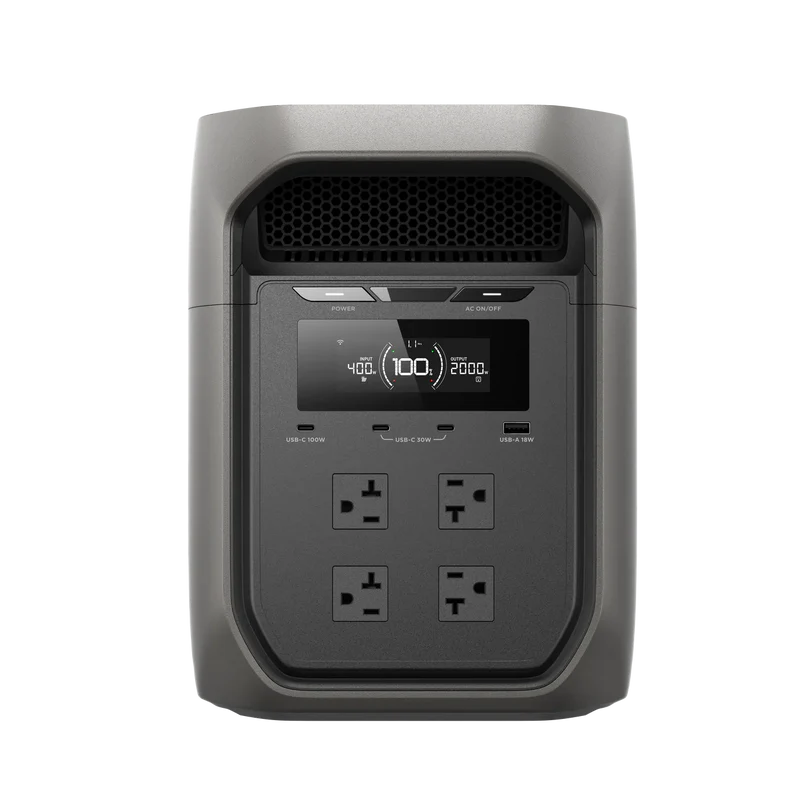

The EcoFlow DELTA 3 Max is the latest addition to EcoFlow’s expanding (and increasingly confusing) 3-series power station lineup. It’s marketed as the successor to the DELTA 2 Max, but calling it an upgrade might be a stretch. Instead, it feels like EcoFlow decided to take a half-step back in performance while making it more affordable and accessible to a wider audience.
To find out if it’s worth your hard-earned money, we tested this new power station thoroughly, and we’re ready to give you the real verdict. So, is this new mid-sized EcoFlow power station a good buy, or should you stick with one of the brand's earlier models?
Before we dive into everything we like and dislike about the EcoFlow DELTA 3 Max, let’s take a look at what this thing is supposed to bring to the table:
{{review-summary}}
After running this latest EcoFlow power station through our standard series of tests, we found it to be surprisingly solid for its price. Here’s how it performed:
The DELTA 3 Max’s 2,048Wh battery charged from 0% to 100% in just 68 minutes using a standard AC house outlet. While that isn’t crazy, being able to charge your power station in just over an hour is going to be really handy in a bunch of different situations.
Let’s say you check the weather and notice a big storm is on its way, you could quickly top up the battery before having to worry about a potential power outage. Even if you’re just heading out on a camping trip, being able to fully charge the battery in the same time it takes you to pack your gear is going to be a plus.
Unfortunately, we can’t say the same when it comes to solar charging this unit. With a solar input of just 500W, it took us over four hours to charge the battery with solar panels, and we had ideal sunlight conditions and an oversized solar panel array at our disposal.
The efficiency came in at 79%, just shy of earning what we consider to be an “A” grade, but that’s still respectable, especially for a mid-range unit.
After a few tests, we calculated the idle consumption at about 27 watts, which means if you leave the AC inverter on but aren’t drawing power from any of its plugs, the DELTA 3 Max should last roughly three days just sitting there. For running intermittent loads, like a refrigerator, that’s a respectable idle draw.
As for the surge handling? EcoFlow’s older models were notoriously poor at that, but this one actually performed much better, showing clear improvements in short power spikes and surge tolerance.
It’s still far from impressive, but we were actually able to hit sustained loads (slightly) over the inverter’s 2,400W continuous output rating. It’s nothing to get excited about, but for a budget-friendly unit from EcoFlow, not shutting down every time you exceed the inverter rating should be seen as a success.
Speaking of surging, EcoFlow seems to have (finally) given up on the whole "X-Boost" marketing for this run of power stations, which is a huge relief. It always seemed like a gimmick to us from the start.
If you're just look at the continuous output, all of the ports function as they should. It’s a relatively basic power station, but it does what EcoFlow says it will, and that’s not something that should be taken for granted in an industry where plenty of units fail to do what the manufacturer advertises.
Now that we’ve covered the basics for this unit, here’s a few of the things we really liked about it:
First off, we really liked the design, which isn’t surprising given that’s kind of the EcoFlow brand’s strong suit.
Still, EcoFlow refined the layout and ergonomics from the EcoFlow DELTA 2 Max. All the major ports are now front-facing, which makes plug management so much easier. You don’t have have cables awkwardly coming out of both ends, and you don't have to spin the unit around just to find a USB port anymore. The only rear connection is the 12V car socket, which is a fair trade-off for keeping the rest up front.
We also like the new modern aesthetic, which carries over from the DELTA 3 Plus. The bigger handles make it more practical to move around, and the build quality feels solid. It's pretty lightweight for its battery capacity, and there’s no creaky plastic or awkward flexing anywhere on the exterior of the build.
Speaking of the design, the fan placement has also improved: with vents now located up top. This allows the unit to run very quietly, even under a full load. This continues EcoFlow’s current trend of releasing ridiculously quiet power stations. We’ve mostly seen this silent fan design used in their bigger power stations, like the DELTA Pro Ultra, but it seems they’ve extended it to some of their more entry-level and mid-sized units.
Whether you’re using it indoors as a backup power solution or at your off-grid campsite, it won’t drown out your peace and quiet. If only Tiny Baby was this quiet...
Next up: performance. The DELTA 3 Max scored 79% efficiency in testing, which is just shy of an "A" grade. Its idle consumption was only 27W, meaning it can sit in standby for about three days without running out of juice.
AC charging is also impressive, hitting a full charge from zero to full in just over an hour, and EcoFlow finally made some progress with surge performance, which was noticeably better than previous models. It’s not elite-tier surge handling yet, but it’s moving in the right direction.
We said all this above, but the main takeaway is just the simple fact that this power station does exactly what it should. It also comes with some nice extras for its price point, like the built-in display and connectivity with EcoFlow’s very impressive app. If you want reasonable performance from a very reputable brand, but don't want to pay premium prices, this unit could fit the bill.
Finally, the price. For roughly $759 (with our discount code), this is a solid entry point into the portable power station market. It’s great to see EcoFlow offering a capable mid-range power station that is actually cheaper than its predecessor, especially when nearly everything else in the world seems to be going up in price due to inflation or just plain corporate greed.
With that said, EcoFlow is kind of following the “less-for-less” model here. The truth is, the older EcoFlow DELTA 2 Max outperforms its younger sibling, but that unit was also priced at well over $1,000 when it was first released. You pay less for this newer version, but you also have to make some compromises on the specifications.
While we genuinely liked a lot of what EcoFlow was trying to do with this unit, it's not without its issues. Here are the main problems we have with the DELTA 3 Max:
Let’s get the big one out of the way: EcoFlow’s product lineup (and website) is a mess right now. The DELTA 3 Max isn’t really the successor to the DELTA 2 Max, as that title actually belongs to the DELTA 3 Max Plus, which is an upgraded and more expensive version of the DELTA 3 Max that supports expansion batteries.
So, if you’re shopping online, you’re probably going to be confused (we certainly were). Why release so many power stations with such confusing names if you’re not going to have linear categories. How is someone supposed to know that a DELTA 3 Max is actually a downgraded version of a DELTA 2 Max? It makes no sense.
Also, please make your website less confusing, EcoFlow. Oh, and can you cut it out with the pop-ups?
Another major drawback is the lack of expansion options. Unlike the DELTA 2 Max or newer “Plus” models EcoFlow has been releasing, the DELTA 3 Max cannot connect to extra batteries.
You’re locked into the 2,048Wh capacity forever. It’s a step backward in flexibility, and the fact that you need to pay extra for a DELTA 3 Max “Plus” version just to get expandability feels like a cash grab.
Then there’s the solar input. Capping it at 500W feels underpowered for a power station of this class. Just like the EcoFlow DELTA 3 Classic, this unit has a single solar input that’s capped way lower than it should be.
For comparison, the older DELTA 2 Max had a 1,000W solar input, meaning this new unit actually performs worse when charging from solar panels. In real-world terms, that’s around four hours of perfect sun to fully recharge the battery.
If you’re camping anywhere other than a field with zero tree cover, getting four hours of flawless sunlight is going to be wishful thinking. Off-grid users, especially those in wooded or shaded areas, will find this limiting.
The lack of a built-in light is a small gripe, but EcoFlow continues to skip adding a basic LED on their larger portable power stations. These are the same power stations they advertise for blackouts and camping trips, so why not add a light? Meanwhile, their tiny River 3 Plus got the light bar treatment, but with a 286Wh battery, that light wouldn’t last long, so what's the point?
Despite its quirks, the EcoFlow DELTA 3 Max is a well-built, reliable, and affordable power station. It’s ideal for anyone wanting a basic home backup power solution for short outages or as a camping power source for small appliances and devices.
With 2,400W of inverter power and a nice variety of ports, it can easily run essentials like fridges, routers, and even small kitchen gear.
But if you’re someone who wants expandable battery capacity, a higher solar input, or a truly future-proof setup, you’ll want to look at the EcoFlow DELTA 3 Max Plus or even the EcoFlow DELTA Pro 3.
